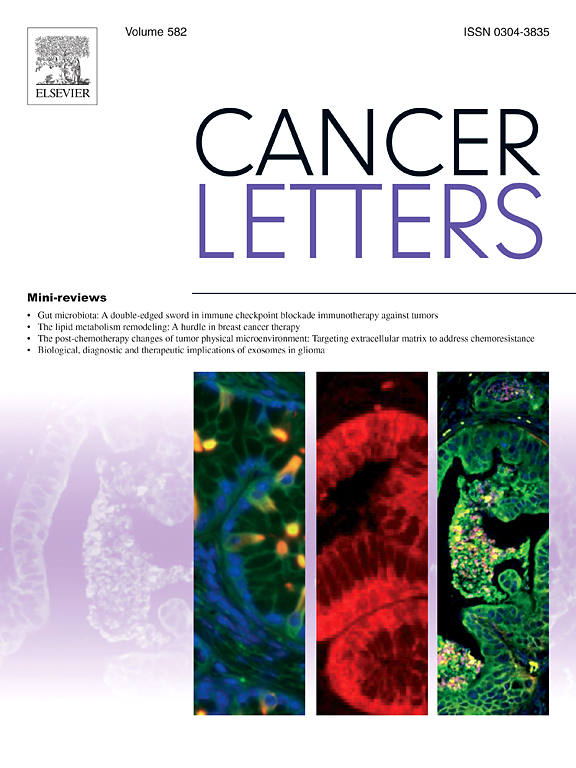Targeting mitochondrial ribosomal protein expression by andrographolide and melatonin for colon cancer treatment
IF 9.1
1区 医学
Q1 ONCOLOGY
引用次数: 0
Abstract
Colospheroids contain colon cancer stem cells (CSCs) that cause colorectal cancer metastasis (mCRC). Colorectal cancer (CRC) is the second leading cause of cancer-related deaths in the U.S. Little is known about the role of mitochondria in the survival and metastatic ability of CSCs. In this study, we investigate the effect of andrographolide (AGP) and melatonin (MLT) on mitochondrial dynamics (including fusion and fission) and the expression of mitochondrial ribosomal proteins (MRPs). Our results show that AGP and MLT synergistically reduce the total active mitochondrial mass, downregulate fusion and fission proteins, reduce OXPHOS proteins, and lead to CSC growth inhibition via Nrf2 and KEAP1 signaling. Microarray revealed 4389 differentially expressed mRNAs in the AGP and MLT combination compared to the control. Results exhibiting a three-fold induction/reduction were validated by qRT-PCR and immunoblot. MRPS6, a mitochondrial ribosomal (Mitoribosome) small subunit protein, was dramatically downregulated by AGP + MLT treatment compared to control. MRPS6 inhibition by siRNA reduced mCRC cell viability. Molecular docking-based protein-ligand interactions showed that AGP has direct physical interaction with MRPS6 and increases the binding affinity of MLT to MRPS6. This drug combination downregulated genes in the NRF2 (NFE2L2) pathway in CSCs. MRPS6 may be directly linked to CSC proliferation and could be a therapeutic target for this population. Functionally, MRPS6 knockdown significantly reduced colony formation, with enhanced suppression in AGP + MLT-treated cells. In xenograft models, the AGP-MLT combination synergistically decreased MRPS6 expression and increased apoptosis, as evidenced by TUNEL assays, demonstrating the therapeutic potential of targeting MRPS6 in CRC.
穿心莲内酯和褪黑素靶向线粒体核糖体蛋白表达治疗结肠癌。
结肠球体含有结肠癌干细胞(CSCs),可引起结直肠癌转移(mCRC)。结直肠癌(CRC)是美国癌症相关死亡的第二大原因,目前对线粒体在结直肠癌存活和转移能力中的作用知之甚少。在这项研究中,我们研究了穿心术内酯(AGP)和褪黑激素(MLT)对线粒体动力学(包括融合和裂变)和线粒体核糖体蛋白(MRPs)表达的影响。我们的研究结果表明,AGP和MLT通过Nrf2和KEAP1信号传导,协同降低线粒体总活性质量,下调融合和裂变蛋白,降低OXPHOS蛋白,导致CSC生长抑制。芯片显示,与对照组相比,AGP和MLT组合中存在4389个差异表达mrna。qRT-PCR和免疫印迹验证了三倍诱导/还原的结果。MRPS6是一种线粒体核糖体小亚基蛋白,与对照组相比,AGP+MLT治疗显著下调了MRPS6的表达。siRNA抑制MRPS6降低了mCRC细胞活力。基于分子对接的蛋白质-配体相互作用表明,AGP与MRPS6有直接的物理相互作用,并增加了MLT与MRPS6的结合亲和力。该药物联合下调CSCs中NRF2 (NFE2L2)通路中的基因。MRPS6可能与CSC增殖直接相关,可能是该人群的治疗靶点。在功能上,MRPS6敲低显著减少集落形成,在AGP+ mlt处理的细胞中抑制作用增强。在异种移植模型中,经TUNEL检测,AGP-MLT联合可协同降低MRPS6的表达并增加细胞凋亡,证明了靶向MRPS6治疗CRC的潜力。
本文章由计算机程序翻译,如有差异,请以英文原文为准。
求助全文
约1分钟内获得全文
求助全文
来源期刊

Cancer letters
医学-肿瘤学
CiteScore
17.70
自引率
2.10%
发文量
427
审稿时长
15 days
期刊介绍:
Cancer Letters is a reputable international journal that serves as a platform for significant and original contributions in cancer research. The journal welcomes both full-length articles and Mini Reviews in the wide-ranging field of basic and translational oncology. Furthermore, it frequently presents Special Issues that shed light on current and topical areas in cancer research.
Cancer Letters is highly interested in various fundamental aspects that can cater to a diverse readership. These areas include the molecular genetics and cell biology of cancer, radiation biology, molecular pathology, hormones and cancer, viral oncology, metastasis, and chemoprevention. The journal actively focuses on experimental therapeutics, particularly the advancement of targeted therapies for personalized cancer medicine, such as metronomic chemotherapy.
By publishing groundbreaking research and promoting advancements in cancer treatments, Cancer Letters aims to actively contribute to the fight against cancer and the improvement of patient outcomes.
 求助内容:
求助内容: 应助结果提醒方式:
应助结果提醒方式:


